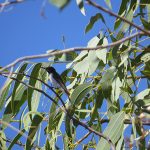BLACK HONEYEATER
The Black Honeyeater is a small bird, measuring about 12-14 cm in length. The male has predominantly black plumage with white underparts and a distinctive white patch on the back of its neck. The female is slightly smaller and has grey-brown plumage with a paler throat and breast.
Black Honeyeaters are native to Australia and are found in various parts of the country where they inhabit open woodlands, shrublands, and forests, particularly in the arid and semi-arid regions of the interior. Despite their striking appearance, Black Honeyeaters can be challenging to spot in the wild. They tend to be secretive and are often found high in the tree canopy or within dense foliage, making them difficult to observe.
As the name suggests, Black Honeyeaters primarily feed on nectar. They have a long, slender, and downward-curving beak that is adapted for reaching deep into flowers to access nectar. The brush-like tip of their tongue helps them lap up the nectar efficiently. In addition to nectar, they also consume small insects and spiders, which they catch while in flight.
During the breeding season, male Black Honeyeaters undergo a dramatic transformation in appearance. Their black plumage becomes more intense, and their white neck patch becomes more prominent. This change in plumage is believed to play a role in attracting mates. They typically breed during the spring and summer months. They construct small cup-shaped nests made of grass, bark, and spider webs. The nests are usually positioned in the fork of a tree branch. The female lays 2-3 eggs, which are incubated for around 14 days. Both parents share the responsibility of incubating the eggs and feeding the young.
These birds are known for their acrobatic flight patterns. They are highly mobile and often move in small flocks, searching for flowering trees and shrubs. Black Honeyeaters are also known to engage in “leapfrogging” behavior, where one bird follows another from tree to tree, possibly to maximize foraging efficiency.
In some areas, habitat loss and degradation due to land clearing and grazing pressure can impact their populations. Nevertheless, they are relatively adaptable and can utilize a range of habitats.
In some areas, habitat loss and degradation due to land clearing and grazing pressure can impact their populations. Nevertheless, they are relatively adaptable and can utilize a range of habitats.

